The secrets of how planets as big as the largest in our Solar System have been revealed by a stunning new image of a young star.
The picture was captured using European Southern Observatory (ESO) telescopes in northern Chile.
It shows huge dusty clumps surrounding a star called V960 Mon, more than 5,000 light-years from Earth in the Monoceros constellation.
Researchers believe these clusters could be the building blocks of massive planets the size of Jupiter, which – at 11 times the diameter of our home world – is the biggest in our Solar System.
Alice Zurlo, of Chile’s Diego Portales University, described the discovery as “truly captivating”.
How were the dusty clumps found?
The new work was based on a picture obtained by the ESO’s Very Large Telescope of V960 Mon.
It attracted astronomers’ attention when its brightness suddenly increased more than 20 times in 2014, during which the surrounding material assembled into spirals extending over distances bigger than the Solar System.
More detailed observations were made using the Atacama Large Millimeter Array.
Ms Zurlo said: “With ALMA, it became apparent that the spiral arms are undergoing fragmentation, resulting in the formation of clumps with masses akin to those of planets.”
How do they form giant planets?
Jupiter-style giant planets are believed to form by one of two means.
The first is core accretion, when dust grains come together to make up the planet.
The other is gravitational instability, when big fragments of material around a star contract and collapse. But this was largely based on theory until now, as it had never been observed.
Sebastian Perez, another researcher on the project from Chile’s University of Santiago, said: “Our group has been searching for signs of how planets form for over 10 years.
“We couldn’t be more thrilled about this incredible discovery.”
Read more:
Star gives possible preview of how Earth dies
Telescope to uncover secrets of dark universe
‘Mind-blowing’ evidence of exoplanets sharing orbit
Further study of the dusty clumps will be possible when the ESO’s Extremely Large Telescope is built.
It’s currently under construction in Chile’s Atacama Desert but is still five years away from completion.
The latest findings have been published in The Astrophysical Journal Letters.

